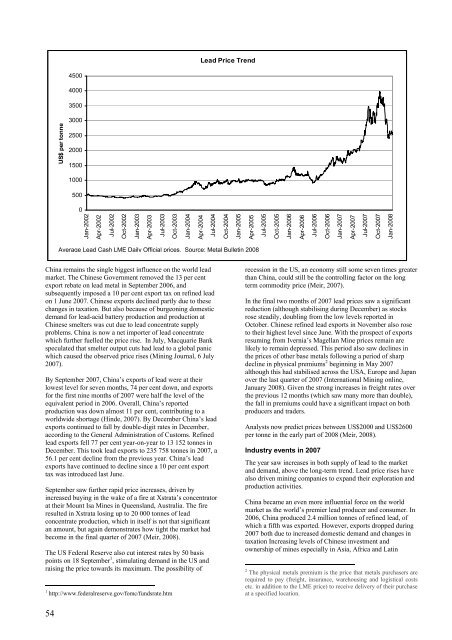World Mineral Production - NERC Open Research Archive - Natural ...
World Mineral Production - NERC Open Research Archive - Natural ...
World Mineral Production - NERC Open Research Archive - Natural ...
Create successful ePaper yourself
Turn your PDF publications into a flip-book with our unique Google optimized e-Paper software.
China remains the single biggest influence on the world lead<br />
market. The Chinese Government removed the 13 per cent<br />
export rebate on lead metal in September 2006, and<br />
subsequently imposed a 10 per cent export tax on refined lead<br />
on 1 June 2007. Chinese exports declined partly due to these<br />
changes in taxation. But also because of burgeoning domestic<br />
demand for lead-acid battery production and production at<br />
Chinese smelters was cut due to lead concentrate supply<br />
problems. China is now a net importer of lead concentrate<br />
which further fuelled the price rise. In July, Macquarie Bank<br />
speculated that smelter output cuts had lead to a global panic<br />
which caused the observed price rises (Mining Journal, 6 July<br />
2007).<br />
By September 2007, China’s exports of lead were at their<br />
lowest level for seven months, 74 per cent down, and exports<br />
for the first nine months of 2007 were half the level of the<br />
equivalent period in 2006. Overall, China’s reported<br />
production was down almost 11 per cent, contributing to a<br />
worldwide shortage (Hinde, 2007). By December China’s lead<br />
exports continued to fall by double-digit rates in December,<br />
according to the General Administration of Customs. Refined<br />
lead exports fell 77 per cent year-on-year to 13 152 tonnes in<br />
December. This took lead exports to 235 758 tonnes in 2007, a<br />
56.1 per cent decline from the previous year. China’s lead<br />
exports have continued to decline since a 10 per cent export<br />
tax was introduced last June.<br />
September saw further rapid price increases, driven by<br />
increased buying in the wake of a fire at Xstrata’s concentrator<br />
at their Mount Isa Mines in Queensland, Australia. The fire<br />
resulted in Xstrata losing up to 20 000 tonnes of lead<br />
concentrate production, which in itself is not that significant<br />
an amount, but again demonstrates how tight the market had<br />
become in the final quarter of 2007 (Meir, 2008).<br />
The US Federal Reserve also cut interest rates by 50 basis<br />
points on 18 September 1 , stimulating demand in the US and<br />
raising the price towards its maximum. The possibility of<br />
1 http://www.federalreserve.gov/fomc/fundsrate.htm<br />
54<br />
US$ per tonne<br />
4500<br />
4000<br />
3500<br />
3000<br />
2500<br />
2000<br />
1500<br />
1000<br />
500<br />
0<br />
Jan-2002<br />
Apr-2002<br />
Jul-2002<br />
Oct-2002<br />
Jan-2003<br />
Apr-2003<br />
Jul-2003<br />
Lead Price Trend<br />
Average Lead Cash LME Daily Official prices. Source: Metal Bulletin 2008<br />
Oct-2003<br />
Jan-2004<br />
Apr-2004<br />
Jul-2004<br />
Oct-2004<br />
Jan-2005<br />
Apr-2005<br />
Jul-2005<br />
Oct-2005<br />
Jan-2006<br />
Apr-2006<br />
Jul-2006<br />
recession in the US, an economy still some seven times greater<br />
than China, could still be the controlling factor on the long<br />
term commodity price (Meir, 2007).<br />
In the final two months of 2007 lead prices saw a significant<br />
reduction (although stabilising during December) as stocks<br />
rose steadily, doubling from the low levels reported in<br />
October. Chinese refined lead exports in November also rose<br />
to their highest level since June. With the prospect of exports<br />
resuming from Ivernia’s Magellan Mine prices remain are<br />
likely to remain depressed. This period also saw declines in<br />
the prices of other base metals following a period of sharp<br />
decline in physical premiums 2 beginning in May 2007<br />
although this had stabilised across the USA, Europe and Japan<br />
over the last quarter of 2007 (International Mining online,<br />
January 2008). Given the strong increases in freight rates over<br />
the previous 12 months (which saw many more than double),<br />
the fall in premiums could have a significant impact on both<br />
producers and traders.<br />
Analysts now predict prices between US$2000 and US$2600<br />
per tonne in the early part of 2008 (Meir, 2008).<br />
Industry events in 2007<br />
Oct-2006<br />
The year saw increases in both supply of lead to the market<br />
and demand, above the long-term trend. Lead price rises have<br />
also driven mining companies to expand their exploration and<br />
production activities.<br />
China became an even more influential force on the world<br />
market as the world’s premier lead producer and consumer. In<br />
2006, China produced 2.4 million tonnes of refined lead, of<br />
which a fifth was exported. However, exports dropped during<br />
2007 both due to increased domestic demand and changes in<br />
taxation Increasing levels of Chinese investment and<br />
ownership of mines especially in Asia, Africa and Latin<br />
2 The physical metals premium is the price that metals purchasers are<br />
required to pay (freight, insurance, warehousing and logistical costs<br />
etc. in addition to the LME price) to receive delivery of their purchase<br />
at a specified location.<br />
Jan-2007<br />
Apr-2007<br />
Jul-2007<br />
Oct-2007<br />
Jan-2008

















